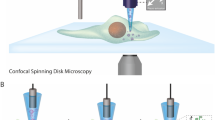Abstract
SEVERAL apparatuses have been described for measuring the electrical charge of small particles, such as cells1–9. Due to the relatively large volume of the chambers used, and the minimum cell concentration necessary for adequate measurements, the total number of cells required for each measurement is rather large. When working with small samples, one sometimes finds it impossible to meet these requirements, and micromethods have therefore been developed. Theoretically, three different approaches are possible: to decrease the total volume of the chamber, to build the apparatus from several parts and fill only one of them with the cell suspension, or to introduce the sample to the measuring-place of a previously-filled chamber. The first of these possibilities is made complicated because of contamination by the electrodes. The second has been used by Seaman and Heard10, who built their apparatus from three parts. In their device only the microelectrophoresis tube is filled with the sample, while the electrode compartments remain ‘cell-free’. This system handles samples of the order of 1 ml. or even less. The third possibility has recently been explored by Forrester et al.11, who have been able to reduce the minimum suspension volume to 0.1–0.2 ml. (ref. 12). The small size and low cell numbers of the organ rudiments we have been investigating have forced us to use even smaller volumes. This led us to modify the apparatus described by Bangham et al.9.
This is a preview of subscription content, access via your institution
Access options
Subscribe to this journal
Receive 51 print issues and online access
$199.00 per year
only $3.90 per issue
Buy this article
- Purchase on Springer Link
- Instant access to full article PDF
Prices may be subject to local taxes which are calculated during checkout
Similar content being viewed by others
References
Northrop, J. H., and Kunitz, M., J. Gen. Physiol., 7, 729 (1924–25).
Abrahamson, H. A., J. Gen. Physiol., 12, 469 (1928–29).
Moyer, L. S., J. Bact., 31, 531 (1936).
Hartman, R. S., Bateman, J. B., and Lauffer, M. A., Arch. Biochem. Biophys., 39, 56 (1952).
Gitten, G. J., and James, A. M., Anal. Biochem., 1, 478 (1960).
Mattson, S., J. Phys. Chem., 37, 223 (1933).
Smith, M. E., and Lisse, M. W., J. Phys. Chem., 40, 399 (1936).
Rutgers, A. J., Facq, L., and van der Minne, J. L., Nature, 166, 100 (1950).
Bangham, A. D., Flemans, R., Heard, D. H., and Seaman, G. V. F., Nature, 182, 642 (1958).
Seaman, G. V. F., and Heard, D. H., Blood, 18, 599 (1961).
Forrester, J. A., Ambrose, E. J., and MacPherson, J. A., Nature, 196 1068. (1962).
Forrester, J. A. (personal communication).
Brinton, C. C., and Lauffer, M. A., in Electrophoresis, edit. by Bier, M. (Academic Press, 1959).
Bangham, A. D., Pethica, B. A., and Seaman, G. V. F., Biochem. J., 69, 12 (1958).
Seaman, G. V. F., Kok, D. A., and Heard, D. H., Clin. Sci., 23, 115 (1962).
Author information
Authors and Affiliations
Rights and permissions
About this article
Cite this article
HÄYRY, P., SAXÉN, L. Micro-technique for Cell Electrophoresis. Nature 205, 1105–1106 (1965). https://doi.org/10.1038/2051105b0
Issue Date:
DOI: https://doi.org/10.1038/2051105b0
This article is cited by
-
Cell electrophoresis on a chip: what can we know from the changes in electrophoretic mobility?
Analytical and Bioanalytical Chemistry (2008)
-
Ein einfaches Zellelektrophoresegerät für kleine Materialmengen
Klinische Wochenschrift (1967)
Comments
By submitting a comment you agree to abide by our Terms and Community Guidelines. If you find something abusive or that does not comply with our terms or guidelines please flag it as inappropriate.



